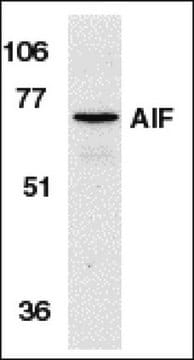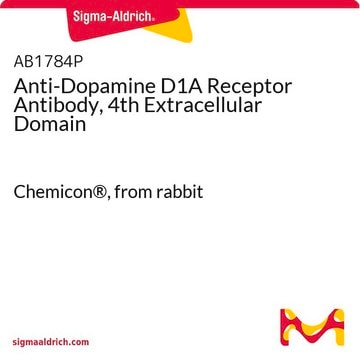AB1787P
Anti-Dopamine D4 Receptor Antibody, extracellular domain
Chemicon®, from rabbit
About This Item
Empfohlene Produkte
Biologische Quelle
rabbit
Qualitätsniveau
Antikörperform
affinity purified immunoglobulin
Antikörper-Produkttyp
primary antibodies
Klon
polyclonal
Aufgereinigt durch
affinity chromatography
Speziesreaktivität
mouse
Hersteller/Markenname
Chemicon®
Methode(n)
ELISA: suitable
western blot: suitable
NCBI-Hinterlegungsnummer
UniProt-Hinterlegungsnummer
Versandbedingung
dry ice
Posttranslationale Modifikation Target
unmodified
Angaben zum Gen
mouse ... Drd4(13491)
Spezifität
SPECIES REACTIVITIES: The immunogen peptide shows sequence homology of 90% with rat and human D4 receptors (Van Tol et al. 1992; Legerski & Peterson 1992; Livingstone et al. 1992; Seeman et al. 1994; O′Malley et al. 1992). Antibody cross-reactivity with D4R from various species is not known.
Immunogen
Anwendung
Neurowissenschaft
Neurotransmitter & Rezeptoren
ELISA: 0.5-1.0 μg/mL (1 μg/mL immunogen peptide/well)
Not tested in immunohistochemical methods.
Optimal working dilutions must be determined by the end user.
Verlinkung
Physikalische Form
Lagerung und Haltbarkeit
Sonstige Hinweise
Rechtliche Hinweise
Haftungsausschluss
Not finding the right product?
Try our Produkt-Auswahlhilfe.
Lagerklassenschlüssel
10 - Combustible liquids
WGK
WGK 2
Flammpunkt (°F)
Not applicable
Flammpunkt (°C)
Not applicable
Analysenzertifikate (COA)
Suchen Sie nach Analysenzertifikate (COA), indem Sie die Lot-/Chargennummer des Produkts eingeben. Lot- und Chargennummern sind auf dem Produktetikett hinter den Wörtern ‘Lot’ oder ‘Batch’ (Lot oder Charge) zu finden.
Besitzen Sie dieses Produkt bereits?
In der Dokumentenbibliothek finden Sie die Dokumentation zu den Produkten, die Sie kürzlich erworben haben.
Unser Team von Wissenschaftlern verfügt über Erfahrung in allen Forschungsbereichen einschließlich Life Science, Materialwissenschaften, chemischer Synthese, Chromatographie, Analytik und vielen mehr..
Setzen Sie sich mit dem technischen Dienst in Verbindung.








